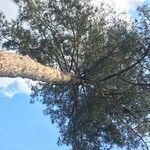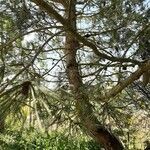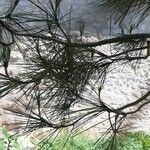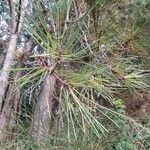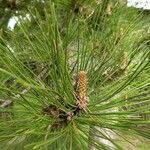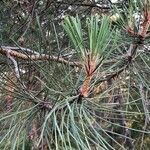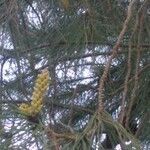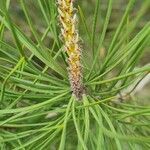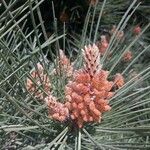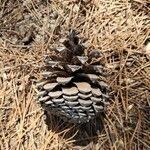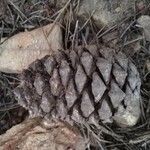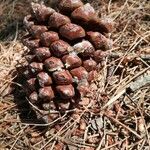Tree, 20-35 m high; bark rough with deep black fissures. Crown open below, dense on top, spreading. Leaves: 2 needles per fascicle; fascicle sheath persistent, 20-30 mm long; needle 50-250 mm long, stiff, rigid, smooth. Spring shoots uninodal or multinodal. Branchlets bright reddish brown, pubescent, glabrous or covered with scale scars; leaves terminally clustered. Male strobili scattered on lower parts of new shoots. Cones terminal on branchlets; 1-6 or more in a whorl; indehiscent, serotinous for several years; purplish when young, then shiny nut-brown; broadly ovate to conical, 100-200 x 50-80 mm; scales 40 x 20 mm, rhomboidal, smooth, lustrous nut-or rufous-brown. Seeds 10 mm long, oblong-ovoid, apex bluntly notched, greyish brown.
Tree to 35 m tall. Bark grey, becoming black with age, broken into broad, deep, black fissures and flat plates which shed irregularly to leave red-brown scars. Resting buds cylindrical, 20-50 mm long, brown, non-resinous, with fringed, apically reflexed, deciduous scales. Leaves glossy, dark green, finely toothed, 8-30 cm long, in bundles of 2, with more than 6 external and medial resin canals; basal sheath 20-30 mm long. Female cones solitary or clustered, sessile, conical to ovoid, slightly asymmetric, 8-25 cm long, often persisting on tree for 1-several years after maturity; scales oblong, keeled but not spinose. Seeds with a well-developed wing.
Trees to 30 m in native range; bark brown, deeply and irregularly longitudinally furrowed; branches sometimes pendulous, forming a pyramidal crown; branchlets pale reddish brown, producing 1-few nodes each year; winter buds brown, oblong, resinous. Needles 2 per bundle, bright green, usually twisted, 10-20 cm × ca. 2 mm, stiff, resin canals 6, median. Seed cones clustered, shortly pedunculate, conical-or ellipsoid-ovoid, symmetric or asymmetric, 9-18 cm. Apophyses brown, lustrous, conspicuously pyramidal; umbo slightly projecting and pungent.
Pyramidal tree up to 40 m high. Bark deeply fissured, reddish-brown. Young shoots glabrous, pale brown, becoming prominently ridged and roughened by the bases of scale leaves. Winter buds stout, 20-25 mm or more long, spindle-shaped, with whitish-brown, fringed, reflexed scales. Leaves dark green, in bundles of 2, rigid, 5-20 cm long. Female strobiles subterminal, sessile, in clusters of 1-many, 7-20 cm long, ovoid-conic, light reddish-brown; scales keeled, with a prominent, prickly umbo. Seeds 7-8 mm long with a wing 25-35 mm long.
Up to 40 m; bark becoming deeply fissured, reddish-brown. Buds oblong, fusiform, not resinous. Twigs glabrous, reddish-brown. Leaves 100-250 x 2 mm, in pairs, green, rigid and spiny; resin-canals 2-9, median. Cone 8-22 x 5-8 cm, conic-ovoid, symmetrical or almost so, light brown, shining; apophysis rhomboidal, keeled, with prominent, prickly umbo. Seeds 7-8 mm; wing up to 30 mm.
Monoecious, pyramidal tree to 40 m. Leaves needle-like, 80-240 mm long, in bundles of 2, grey-green, sparse and rigid. Cones often clustered, ovoid-conic, scales narrow, carinate with recurved apiculus.
A tree.
